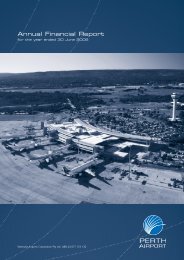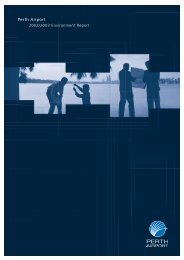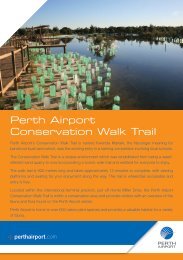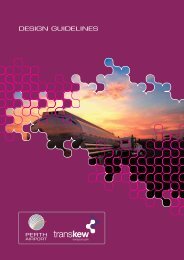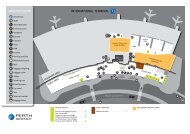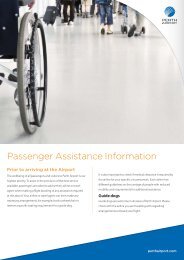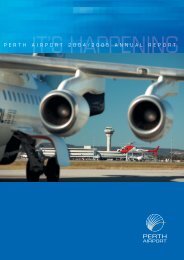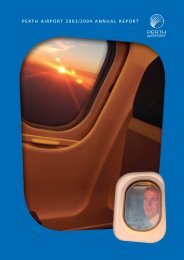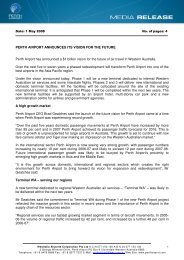PERTH AIRPORT Master Plan 2009
PERTH AIRPORT Master Plan 2009
PERTH AIRPORT Master Plan 2009
You also want an ePaper? Increase the reach of your titles
YUMPU automatically turns print PDFs into web optimized ePapers that Google loves.
P E R T H A I R P O R T M a s t e r P l a n 2 0 0 9<br />
10. Drainage and Hydrology<br />
About this Chapter<br />
This chapter describes the existing drainage system,<br />
identifies current capacity issues and describes the strategy<br />
to develop a system that can support the proposed airport<br />
development described in the <strong>Master</strong> <strong>Plan</strong>. The connection<br />
between drainage system development and Perth Airport’s<br />
Environmental Management Strategy is also identified.<br />
10.1 Existing System<br />
Perth Airport is located between the Darling Escarpment to<br />
the east and the Swan River to the west. As a result of its<br />
location a significant amount of storm water runoff from<br />
catchments outside the airport boundary flows through the<br />
airport on route to the Swan River.<br />
The existing drainage system consists of two major drains<br />
that cross the airport and a series of precinct level systems<br />
designed to control storm water in the developed areas on<br />
the site. Precincts 1 and 3 have independent outfalls outside<br />
the airport estate. The balance of the precinct drainage<br />
system flows into one or other of the main drains.<br />
Southern Main Drain<br />
The Perth Airport Southern Main Drain enters the airport site<br />
via two 900 millimetre diameter pipes from the east into an<br />
open unlined drain. It is then piped under Horrie Miller Drive<br />
and Runway 03L/21R with single 1200 millimetre diameter<br />
pipes. Beyond the airfield the drain reverts to an open unlined<br />
drain which follows Tonkin Highway along the south western<br />
boundary of the airport, leaving the airport site near Brearley<br />
Avenue. The drain then continues in a reserve to the discharge<br />
point into the Swan River near Kanowna Avenue in Redcliffe.<br />
Northern Main Drain<br />
The Perth Northern Main Drain is an open unlined drain that<br />
extends from the International Precinct, around the northern<br />
end of Runway 06/24 and the northern end of the General<br />
Aviation Precinct along each side of Taxiway Romeo. The<br />
drain then exits the airport, is piped under the Great Eastern<br />
Highway Bypass and discharges into the Swan River near<br />
Beverley Terrace.<br />
Precinct 1<br />
This system is a combination of open unlined drains<br />
and piped sections which provides drainage for the<br />
developments, runways, taxiway, aprons, terminals, carparks,<br />
and ground transport facilities in the Domestic Precinct.<br />
The drainage system passes through a compensation<br />
basin and silt and hydrocarbon interceptor on the corner<br />
of Fauntleroy Avenue prior to discharging into the reserve<br />
adjacent to the Swan River.<br />
Precinct 3<br />
This drainage system has its outfall via a set of existing<br />
culverts under the Great Eastern Highway Bypass. As<br />
the authority for this road and the associated drainage<br />
infrastructure, Main Roads Western Australia has provided<br />
maximum outfall capacities for the culvert.<br />
10.2 Drainage System Considerations<br />
The considerations for development of the drainage system<br />
at Perth Airport fall into three main categories:<br />
• External system capacity<br />
• Internal system capacity<br />
• Modifications required for development<br />
External System Capacity<br />
There is currently a significant imbalance between the inflows<br />
to the airport estate and the outlet capacity. This results in a<br />
need for significant compensation within the airport to catch<br />
runoff generated in upstream catchments that historically<br />
used the airport land for their compensation.<br />
The development plans on the airport estate identify other<br />
uses for the land used previously as informal compensation,<br />
which reduces this capacity. It is therefore essential that<br />
development of suitably sized compensation in the upstream<br />
catchments occurs to cater for the runoff generated in these<br />
catchments to reduce the flow onto the airport estate.<br />
Alternatively, approval must be obtained to increase outfall<br />
capacity to match inflow from upstream catchments at the very<br />
least, and ideally allow for a reasonable proportion of runoff<br />
generated on the airport site to be disposed of in the main drains.<br />
89



